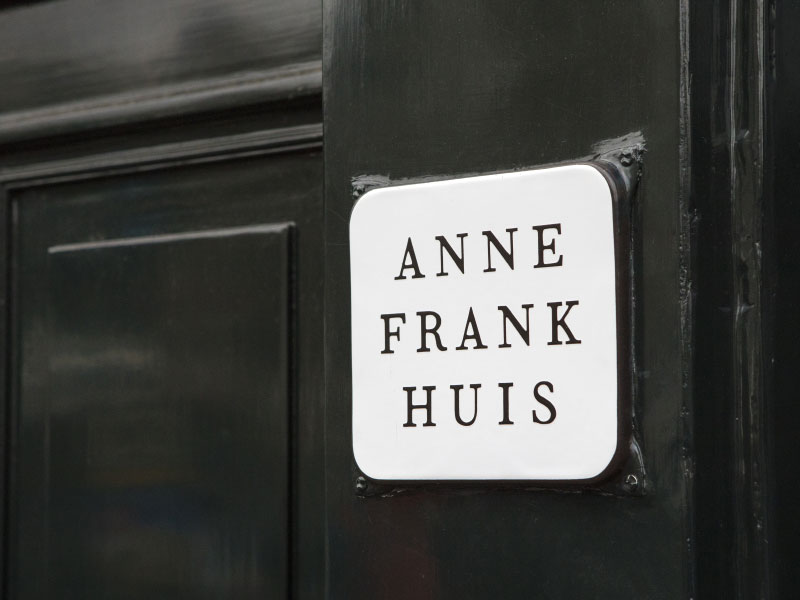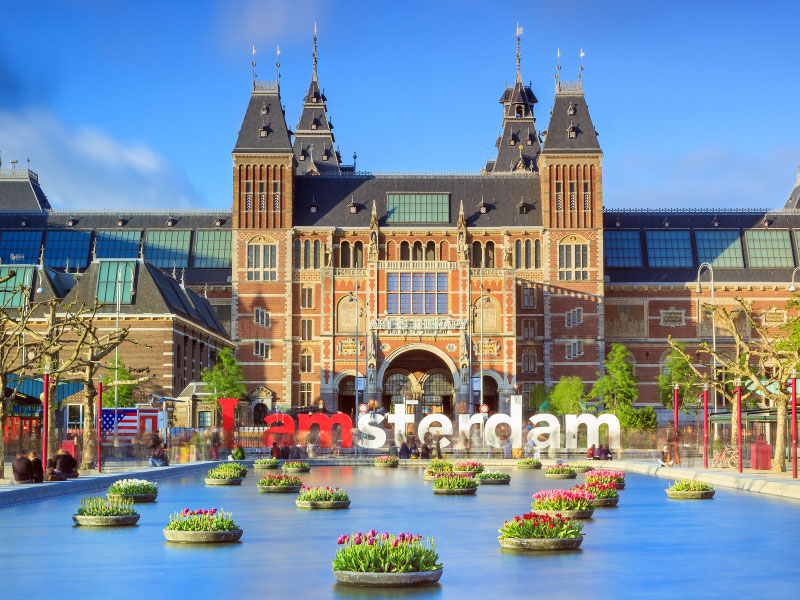Travelling to Amsterdam?
Are you planning on travelling to Amsterdam for work? Get to know the capital of the Netherlands better in this comprehensive guide for business travellers.
Amsterdam, literally (and unsurprisingly) translated as “Dam in the Amstel”, has been an integral part of the country’s business scene since its role as a world port during the Dutch Golden Age of the 17th Century. Then, as now, the city was a leading centre of finance and trade, with the Amsterdam Stock Exchange, founded in 1602, considered the oldest such exchange in the world.
Today, Amsterdam is a dynamic hub of modern business. The southern Zuidas district is a hotbed of innovation and the home of tech giants such as Tesla and Uber, while the Port of Amsterdam is one of the largest ports in Europe, handling a wide range of cargo, including containers, bulk goods, and breakbulk across the North Sea.
But Amsterdam is not all about business. Beyond the boardrooms of major banks and fintech startups is a city with a reputation for being unique. Cobbled streets crisscross between canals that move with the bobbing of colourful Dutch barges and houseboats. Bicycle bells are the soundtrack of the morning commute. Office blocks share the city with vast green spaces like the sprawling, tree-lined Vondelpark.
In this comprehensive guide to Amsterdam for business travellers, we delve deeper into navigating the city’s unique corporate landscape, offer our top tips for getting around, and pick out our top 3 things to see or do to make your trip unforgettable.
Amsterdam Fact File

The coat of arms of Amsterdam.
Languages
Dutch. English is also widely spoken.
Currency
Euro (€)
Avg. Temperatures
Spring (Mar-May) = 7°C (45°F)
Summer (Jun-Aug) = 18°C (64°F)
Autumn (Sep-Nov) = 11°C (52°F)
Winter (Dec-Feb) = 3°C (37°F)
Getting To Amsterdam
By Air
Amsterdam is well-connected by air, with Amsterdam Schiphol Airport the primary international hub. It’s located just 15 kilometres (9.3 miles) from the city centre, making it easily accessible by train, bus, or taxi. Alternatively, travellers can arrive via the smaller Rotterdam The Hague Airport approximately 50 kilometres (31 miles) south of Amsterdam.
By Road
Amsterdam is accessible by car from several major European cities. The A1 is the main highway connecting Amsterdam to the south, leading to cities like Utrecht, Eindhoven, and Brussels The A2 highway connects Amsterdam to the east, and cities like Apeldoorn, Arnhem, and Nijmegen. Finally, the A4 highway connects Amsterdam to the west, leading to cities like The Hague, Rotterdam, and Antwerp.
By Rail
Amsterdam is well-connected by rail, making it easy to reach by train from many European cities. Domestic rail services are frequent while Eurostar and Thalys offer high-speed routes to Amsterdam from London, Paris, and Brussels. The city’s main station is Amsterdam Centraal Station located in the city centre, with Amsterdam Zuid Station in the southern part of the city offering good connections to the airport and other cities.
Business Culture & Etiquette
The Dutch style of doing business is often described as “no-nonsense,” meaning that there’s a preference for clear communication and getting straight to the point. While there is formal respect for hierarchy, it’s not uncommon to see colleagues addressing each other by their first names, even in more senior positions.
Their direct way of doing things means that negotiations are usually pragmatic and results-orientated with little room for lengthy small talk. But don’t mistake Dutch directness for unfriendliness – locals are renowned for being approachable and using humour to break the ice.
Punctuality is highly valued in Dutch business culture, with meetings typically well-structured and time-efficient. Be prepared to follow the agenda items as they are listed and ensure that your contributions are both relevant and concise.
Here are some other business culture & etiquette tips:
- The Netherlands consistently ranks high in international corruption indices for its clean and transparent business environment. In fact, the country was ranked 8th on the list of the least corrupt nations in 2023.
- The Dutch government actively promotes work-life balance through policies such as the Flexicurity Act, which encourages flexible employment arrangements.
Crime & Safety
According to a recent 2024 survey, Amsterdam was ranked the 32nd safest city in the world. Though the latest data from the Dutch Central Bureau of Statistics (CBS) and the Amsterdam Police Department showed approximately 75,000 crimes were reported in 2023, a slight increase from 2022, the overall crime rate of the city when compared to many others across the world is still comparatively low.
As is the case in most major cities, petty crimes such as pickpocketing can cause travellers issues. This is particularly true in areas that are busy at night such as Leidseplein, known as the heart of Amsterdam’s pulsating club scene. Precautions should also be taken if you plan to visit the infamous Red Light District. Though the district is relatively safe at night, you are more likely to run into trouble in the early hours of the morning when tourists start to disperse.
Here are a few of our other top safety tips:
- In Amsterdam, the emergency number for police, fire, and ambulance services is 112.
- Amsterdam is well known as a place where soft drugs such as cannabis and magic truffles can be bought and consumed in shops or coffee houses. If you plan to take these legal drugs, make sure you are aware of the dosage strength and ask the vendor for advice.
Getting Around Amsterdam
Bicycle
In Amsterdam, cycling is not just a method of getting from A to B, it is a way of life. According to some estimates, there are approximately 881,000 bicycles in the city (more than one bike per person!) and 320 miles (515 km) of cycle paths. There are numerous bike rental businesses throughout the city, including A-Bike and Bike Rental Amsterdam, with the average cost of a daily hire around €8 – €10.
Amsterdam Metro
Amsterdam’s metro system, operated by the GVB (Gemeentelijk Vervoerbedrijf), is a convenient and efficient way to get around the city. It consists of 5 lines (50, 51, 52, 53, and 54), serving neighbourhoods across the city. Travellers can purchase single tickets online or from vending machines at metro stations. Alternatively, passengers can use the OV-Chipkaart contactless smart card to pay for their trip.
Tram
Amsterdam boasts an extensive network of modern and well-maintained trams. Line 2, one of the most popular tram lines, connects Centraal Station to the Olympic Stadium and Amsterdam Zuid, Line 5 serves the western part of the city such as Slotermeer, and Line 12 links the city centre with the northern suburbs, including the Zaandam area. Tickets can be bought at tram stops or online. Alternatively, passengers can use the OV-Chipkaart contactless smart card to pay for their trip.
Top 3 Things To See Or Do In Amsterdam
If you find yourself with a bit of free time on your business trip, Amsterdam is a city with a rich history and offers plenty to see and do. Here are our top 3 recommendations…

1. Anne Frank’s House
The Anne Frank House is the former hiding place of Anne Frank, a young Jewish girl who, along with her family and four other Jews, hid from the Nazis during World War II. Visitors embark on a guided tour through the museum, which includes a look at the preserved secret annexe hidden behind a bookcase in the attic.
The stories of Anne Frank and her family, along with the Van Pels family and a dentist named Fritz Pfeffer, serve as a poignant reminder of the horrors of Nazi rule. The central exhibit is Anne Frank’s diary, which she kept during her time in hiding. The diary offers a raw and intimate glimpse into the life of a young girl facing extraordinary circumstances.

2. Rijksmuseum
The Rijksmuseum is one of the most renowned art museums in the world. It is home to a vast collection of Dutch art and history, spanning centuries and showcasing the work of some of the most famous Dutch artists. The works include the iconic “The Night Watch” from one of the country’s most famous painters Rembrandt van Rijn which depicts a company of militia officers and their drummer boy, captured in a dramatic pose.
Alongside other works from Rembrandt, the museum also showcases several Johannes Vermeer masterpieces including “The Jewish Bride,” and “The Anatomy Lesson of Dr. Nicolaes Tulp”. It also houses a vast collection of Dutch Golden Age art spanning the years between 1575 and 1725, including works by Frans Hals, Jacob van Ruisdael, and Jan Steen.

3. Vondelpark
Vondelpark is Amsterdam’s largest public park – a sprawling green space that attracts picnickers, walkers, and sunbathers alike. The numerous lakes and waterways are ideal for casual boating and amateur birdwatching, while the dedicated cycle paths make exploring the miniature countryside a breeze on two wheels.
One of the park’s main attractions is the Vondelpark Openluchttheater, a popular open-air venue which hosts everything from classic plays to contemporary dance performances.
Amsterdam is a city steeped in history and defined by an innovative business scene.
Renowned for its picturesque canals and charming blend of Dutch Renaissance and Baroque architecture, Amsterdam is a city that is hard to forget. With excellent infrastructure, including a well-developed public transportation network and a unique cycling culture, the city is a brilliant business travel destination for international trade backed by plenty of investment.
Transport is big business in the country’s capital. Amsterdam’s Schiphol Airport is one of the busiest airports in Europe, while the Port of Amsterdam consistently ranks as one of the most thriving ports on the continent thanks to its easy access to major North Sea shipping routes. Plus, with major tech companies and banks making themselves at home in the city centre and the Zuidas financial district, there is a range of opportunities for business travellers to explore.
Related Articles
What is the True Value of a TMC?
A recent article from The Business Travel Magazine claims that Travel Management Companies (TMCs) like Gray Dawes are struggling to provide value for their clients. However, at Gray Dawes, we respectfully and heartily disagree… After all, not all TMCs are created equally. Tarring everyone with the same brush only serves to devalue the brilliant work and innovative thinking that organisations such as ours bring to the industry. In this article, we take a deeper look at the “Value Proposition” piece from the Business Travel Magazine and demonstrate how we are genuinely doing things differently.
How the Paris Olympics 2024 will Impact Business Travel (And What You Can Do About It)
The Olympic Games are heading to Paris in July. Over 10,000 athletes will be throwing, swimming, running, cycling, and more for the chance to grab a gold medal and write themselves into the annals of Olympic history. But with an estimated 15 million visitors planning to head to the event according to the Paris je t’aime tourist office, travelling to and within Europe for work will almost certainly be affected. In this article, we take a look at how the Paris Olympics 2024 might impact business travel and offer our expert tips and advice to help you keep your trip on course.
ITA Airways Insider
ITA Airways aim to create an efficient and innovative service that places its customers at the centre of everything it does. Their pledge to provide a personal, best-in-class experience through digital innovations, combined with their commitment to sustainability – including the use of new, greener aircraft -underpins their sky-high mission for 2024 and beyond. Plus, with new equality and inclusion strategies in place to foster gender-neutral workplaces, it’s an exciting time to be a part of the ITA Airways team.
LET'S TALK
Fill in the form below and we'll get back to you as soon as we can.


